
![]()
Sociedad Ibero-Americana de la Historia
de la Fotografia Museo Fotográfico y Archivo Historico "Adolfo Alexander"
Fórum Yahoo [maquinas russas]
Hong
Qi
Also Dong Feng and
Heping
Two
extraordinary Dong Feng (Eastern Wind) and Hong Qi (Red Flag) photo cameras were built in
Also two movie cameras Hong Qi for 16mm and Heping (Peace) for 35mm film
with the same high quality level, at the world’s top standards.
Here, the 6X6 camera with
normal lens (3rd Version)

Here
the outfit. These high grade cameras were sold in kit form in order to impress
foreign people.

The wide angle
and telephoto lenses with their own “Compur “ type shutters.(w/ 1/1000 top speed !)
Lenses are
direct copy of 80mm Planar, 50mm Distagon and 150mm
Tele-Tessar.
The body of
course, is a direct Hasselblad 500 series descendant.


zhang xk comment:
Dong Feng 120 SLR ,like the Red Flag
20, is another attempt to produce a top end camera. It is a copy of a Hasselblad 500C, but with a top speed of 1/1000 second.
Only 97 cameas were made in three slightly different
variations.
An outfit was retailed
at more than RMB 9000 in the 1970's, when a Leica M3
with a normal lens was only about RMB2000-3000.
So the camera was hard to sell for the very high price.
The owner of this camera is a well known Chinese camera collector. I heard that
he sold part of his collection of vintage Chinese cameras a few years ago for
US$100,000. He also has some other versions of this camera.
BTW, a
But don't take the price information seriously. That only gives you a rough
idea. But the Rolex was a fake!
First
version as Dong Feng (Eastern Wind) 1/1000 maximum shutter
speed
In
this version, film magazine is opened by a back door for loading (Bronica style)

J. Paul comment:
I think, to be able perhaps to answer some of your questions on
this mythic camera
I had luck, indeed, to
meet and to question for a long time on this topic, about fifteen year ago, a
representative French
dealer on
He was, during this period,
exclusive importer of Chinese machine-tools and camera bottoms of range ( maybe Seagull ???) , for
Between 69 and 73, they worked, and after these 4
years made birth the 1st body.
- It also had to be offered, as
gift for guests of mark. - Fidel Castro, Tito and I.Gandi
would have received one of it in " case ". I
will come back there later... and in gifts " of honor" to the
politicians, policies/military of high ranks and maybe science people…
- According to MX, since China had
to convince the west as well as the Orient, of its supremacy, the chosen shape,
characteristic of the device was a mixture of Leica
M4-M5 and Canon 7. The " look " of the
device becoming thus " universal ".
- It was chosen Leica bayonet " M " on the lenses and camera , this
prevented all import and merchandising outside China, because patent rights, in
most countries and in particular the industrialized western countries,
including Japan. So the RF20 was in fact, unmarketable outside
- For what concerns the produced
quantities, MX informed me that one had told him that he had been manufactured
198 bodies - for all product in 1973.
- 198 x 1.4/50 lenses made between
1973 and 1974
and 72 x 1.4/35 and 2/90 between
1974 and 1975.
- Contrary to what is sometimes
said, MX , had never heard about the construction of a
scientific body without view-rangefinder.
- Rigid “ case " made of
black leather, stamped of the acronym gold RED FLAG 20, with the inside made of
red velvet would have been produced according to the needs for prestigious
gifts. About 30 pieces would have been produced. These cases could contain the
body and its 3 lenses, has place for 10 circular filters and a pitfall to
accommodate 4 X 35mm films in its side.
- This material was clearly
unknown in
- MX had to send back to
In 1975 - 1976,
- At the end of 1978, other people contacted MX. One proposed him to send back
the complete Hong Qi outfit case to China or to keep it against
the sum of 1.000 $. MX decided to keep this camera and to use it in complement
of his M3. He used the RF20 regularly during 20 years, without problem,; what proves that the quality of this material is very
good.
- Optics are judged excellent by
MX, exact Leica copies of :
- 1.4/50 Summilux
- 1.4/35 Summilux
- and 2/90 Summicrons.
- The optics for Leica " M " are perfectly usable on the RF20 and
those of the RF20 on the Leica bodies except, of
course, CL. Mount and rangefinder system being precisely identical.
- MX didn't speak the use that one
made to some RF20s, except that the address for back "
its " RF20 was, " military ".
RF20 and its 3 optics are a really
exceptional quality and are perfectly interchangeable with the Leicas M. lenses
Body n°: 73001 -The first RF20
body made !
Lens f1.4/50 n°: 740021 - it
possesses a sunshade dedicated for 48mm diameter. This sunshade, put makes plug
upside-down the lens.
Lens f1.4/35 n°: 75009
Lens f2/90 n°: 750052 - it
possesses, as the Summicron, a built-in sunshade and
a nut of foot.
My long discussion with MX, having
convinced me of the exactness of his subjects.
Thank you, and
Cheers
J - Paul

Hong Qi 20 and normal lens

Hong
Qi 20 with 90mm lens

Hong Qi
20

Hong Qi 20 normal
lens, sunshade and eveready case

Three lens
outfit and case

Outfit
2nd view
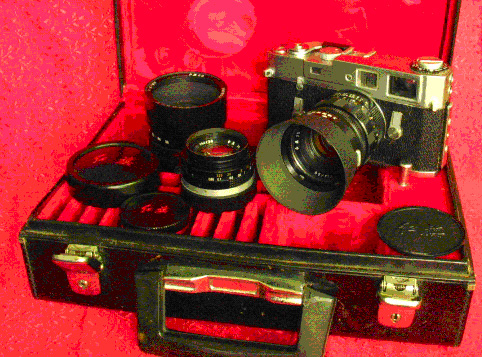
Outfit 3rd view
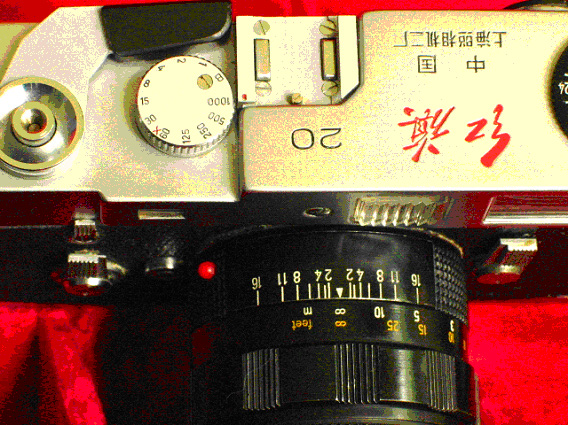
with 50mm lens
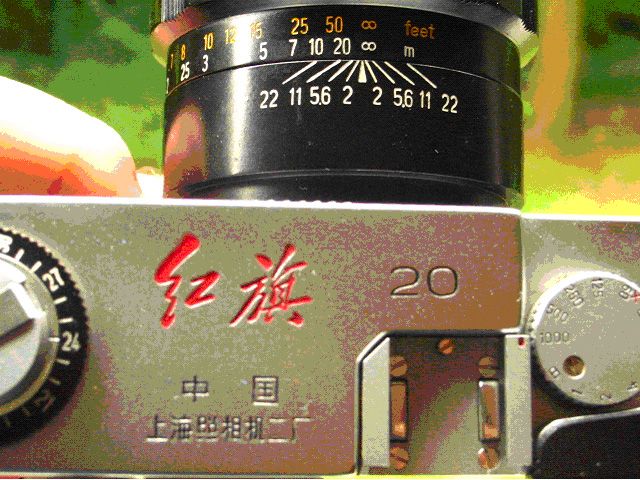
with
90mm lens
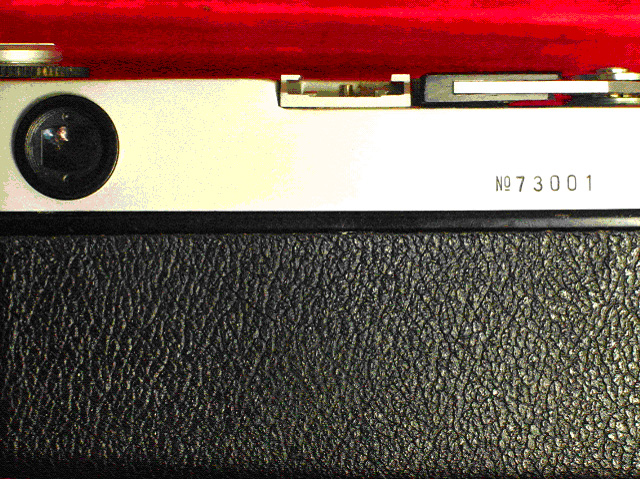
Rear
view: The first body made!
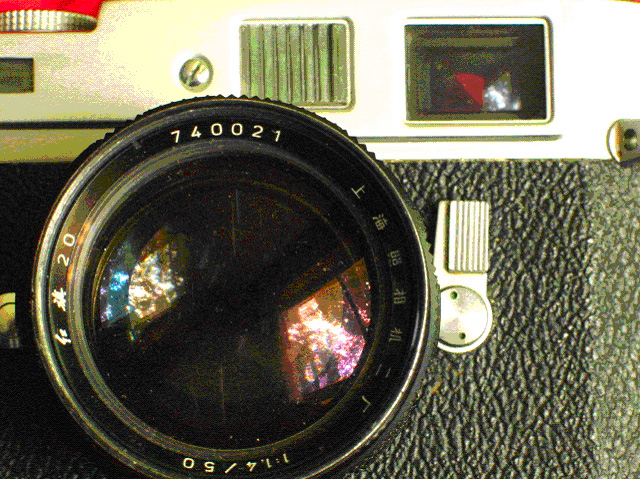
Front view
1.4/50
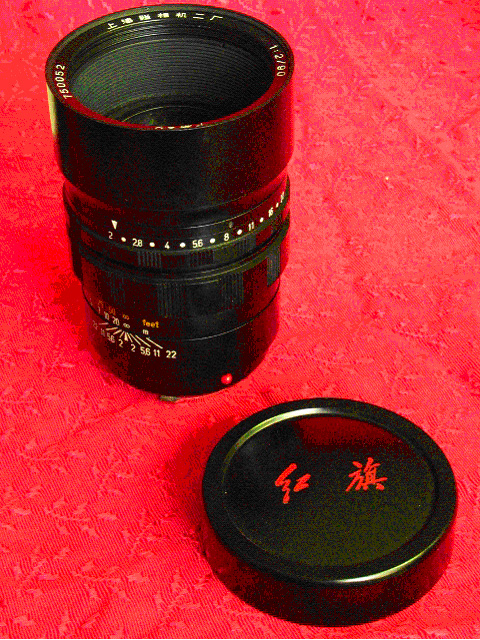
f2/90mm telephoto
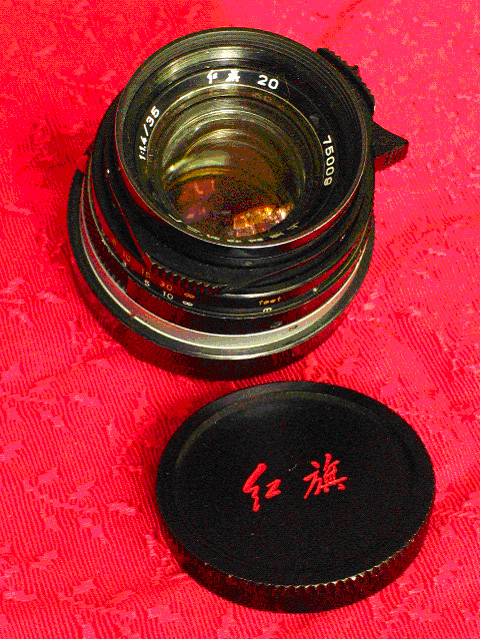
f
1.4/35mm wide angle
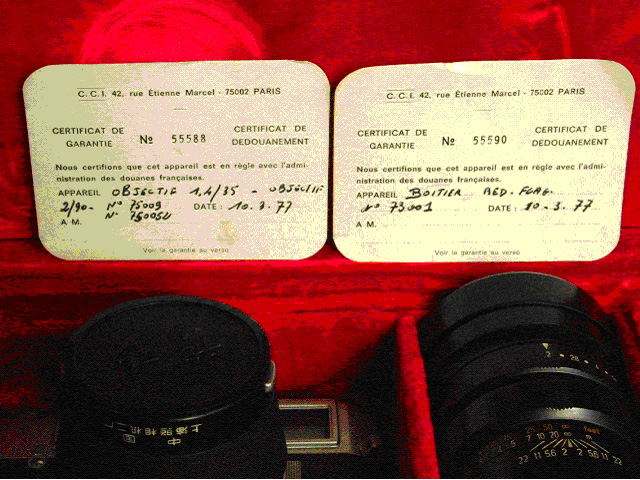
Lenses with French Customs liberation cards.
photocrazy comment:
The Red Flag 20 is
actually a copy of Leica M3 and M4, and possibly the
only one in the world. Mao's wife, Madam Jiang Qing was very keen on photography. She worked as an
actress in

Hong
Qi 20 at 1977 Fair of
Yes ! Hong Qi also
was a movie camera!
Hong Qi S-16

Made in the
Guangzhou Optical Research Institute factory is here seen with three fixed
focal lenses and one zoom lens. They are 1,9/16mm:
1.5/25mm : 1.8/50mm and a Zoom 1.8 20-70mm Reflex finder and Bolex RX Mount 12 to
36 fps speeds
In a new
developed body one can easily see tre strong Paillard Bolex influences. Even
to the Kern objectives,
As the RED FLAG
camera, it sports its name with the Mao’s caligraphy.

Inside view. One can clearly see the Bolex film loop forming guides
And why not a 35 mm professional movie camera?
Now the Arriflex
inspired the
Heping
(Peace)
